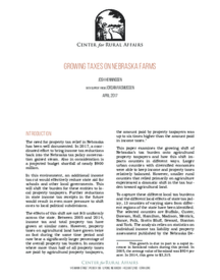The need for property tax relief in Nebraska has been well documented. In 2017, a coordinated effort to bring income tax reductions back into the Nebraska tax policy conversation gained steam. Also in consideration is a projected budget shortfall of nearly $900 million.
In this environment, an additional income tax cut would effectively reduce state aid for schools and other local governments. This will shift the burden for these entities to local property taxpayers. Further reductions in state income tax receipts in the future would result in even more pressure to shift costs to local political subdivisions.
The effects of this shift are not felt uniformly across the state. Between 2005 and 2014, income tax and total property tax have grown at similar rates. However, property taxes on agricultural land have grown twice as fast during the same time period and now bear a significantly larger percentage of the overall property tax burden. In counties where more than half of all property taxes are paid by agricultural property taxpayers, the amount paid by property taxpayers was up to six times higher than the amount paid in income taxes.
This paper examines the growing shift of Nebraska’s tax burden onto agricultural property taxpayers and how this shift impacts counties in different ways. Larger urban counties with diversified economies were able to keep income and property taxes relatively balanced. However, smaller rural counties that relied primarily on agriculture experienced a dramatic shift in the tax burden toward agricultural land.
To capture these different local tax burdens and the different local effects of state tax policy, 13 counties of varying sizes from different regions of the state have been identified. The selected counties are Buffalo, Custer, Dawson, Hall, Hamilton, Madison, Merrick, Nance, Polk, Scotts Bluff, Seward, Stanton and York. The analysis relies on statistics on individual income tax liability and property assessment published by the Nebraska Department of Revenue and focuses on a 10-year period from 2005 to 2014.


